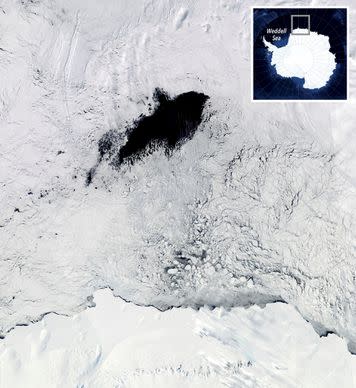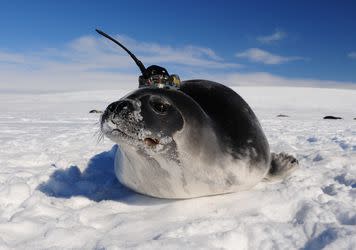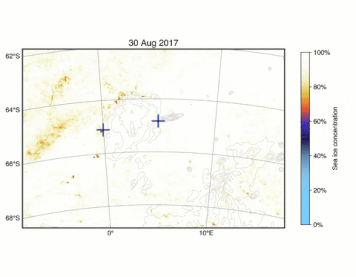Super colossal holes in Antarctic ice demystified by scientists

It’s a strange thing. In the dead of the subzero Antarctic winter, when the oceans at the bottom of the world are frozen over, scientists have observed massive holes the size of South Carolina or larger opening up in the sea ice.
The rare, puzzling phenomena occurred most recently in the winters of 2016 and 2017, though considerably larger holes opened up in the 1970s. Now, scientists have a good grasp of why such great holes, known as polynyas (Russian for "hole in the ice"), form.
A slew of environmental factors must come together at the same time for the great ice voids to open up. The research, published Monday in the journal Nature, used observations taken from big floats in the remote ocean, NASA satellites, and even sensors attached to the heads of elephant seals to show how the ocean under the ice gets mixed up, like a bartender shaking up a cocktail. Ultimately, this mixing transports relatively warmer water up to the surface.
"The water’s warm enough to melt ice," said Ethan Campbell, lead author of the study and a University of Washington Ph.D. student in physical oceanography.
That dooms great swaths of ice. And there's growing evidence that these striking bouts of warming might start happening more often.
It’s not a gradual event. The gaping holes form rapidly, without notice. "Suddenly a hole appears in the floating ice," said Ted Scambos, an Antarctic expert and senior research scientist at Colorado State’s Earth Science and Observation Center. The ice is a few meters thick, added Scambos, who had no role in the study.

Image: NASA Worldview / NASA Blue Marble
There is, of course, another massive component of the large polynyas that can’t be ignored, emphasized Scambos. It’s called Maud Rise, and it’s a massive submarine mountain that lies in the vicinity of these holes. "You can think of it as a Mount Everest under the ocean," said Campbell, noting that the tall mount's shape and topography amplifies the movement of warm waters to the surface.
But, Campbell noted, "[Maud Rise] is there every day, but we don’t see polynyas every year. To explain polynyas we had to go to the ocean."
The key ingredient is violent storms (something previous research had suggested). And during winter the ocean surrounding Antarctica, called the Southern Ocean, is a hellish place. "It’s characterized by storms every single day, with almost hurricane force winds," noted Campbell. The gnarly winds rock the ice, perturbing the water beneath, and blow directly through cracks, hollows, and gaps in the sea ice, he explained. This can force a profoundly chilled layer of water near the surface to mix down, allowing warmer, saltier water to well up — and melt the ice.

Image: Dan Costa / University of California, Santa Cruz
Crucially, some years the winds swirling around Antarctica wrap tighter and closer around the great ice-clad continent, meaning exceptionally strong gusts can pummel the sea ice and force an exceptional shake-up of the waters below, leading to massive polynyas.
The amount of heat coming up with this warmer water is profound.
"We have this huge, incredible release of heat," said Alek Petty, a polar sea ice scientist at the NASA Goddard Space Flight Center who had no role in the research. The amount of heat set free by these gaping holes is equivalent to the total amount of heat usually lost from the Southern Ocean over the entire winter, Petty added. This gushing firehose of exposed warmth then gets absorbed into the atmosphere, where it can have a global effect on weather patterns, even influencing where it rains (for years at a time) in the tropics.
So, scientists like Petty are now watching polynyas closely. They’re not just giant, intriguing curiosities in a remote part of the world.
SEE ALSO: Fearless TV weather forecasters air the planet's soaring carbon levels
“These are a very fundamental part of the climate system,” said Petty.
And, as the climate changes, polynyas may become more common. "We might start to see these things more often," said the University of Washington’s Campbell. As a consequence of the planet’s overall climate disruption, atmospheric scientists expect the winds circling Antarctica to grow stronger — which could very well mean more polynyas.

Image: University of Washington
What’s more, the same upwelling of heat that allows these great polynyas to form could also find its way to the increasingly vulnerable Antarctic ice shelves — which are the ends of giant glaciers that float over the ocean. Warmer waters are already deteriorating these masses of ice, which act like plugs holding back Antarctic sheets from flowing unimpeded into the ocean.
But with more polynyas, there might be a new source of heat amplifying the modern threat to the greatest store of ice on the planet.
"It’s a future area of research," said Petty, noting that NASA plans to study the phenomenon. "Is that going to be another source of heat and melt?"
WATCH: Meet Katie Bouman, one of the scientists who helped capture the first black hole image


